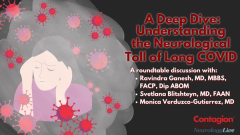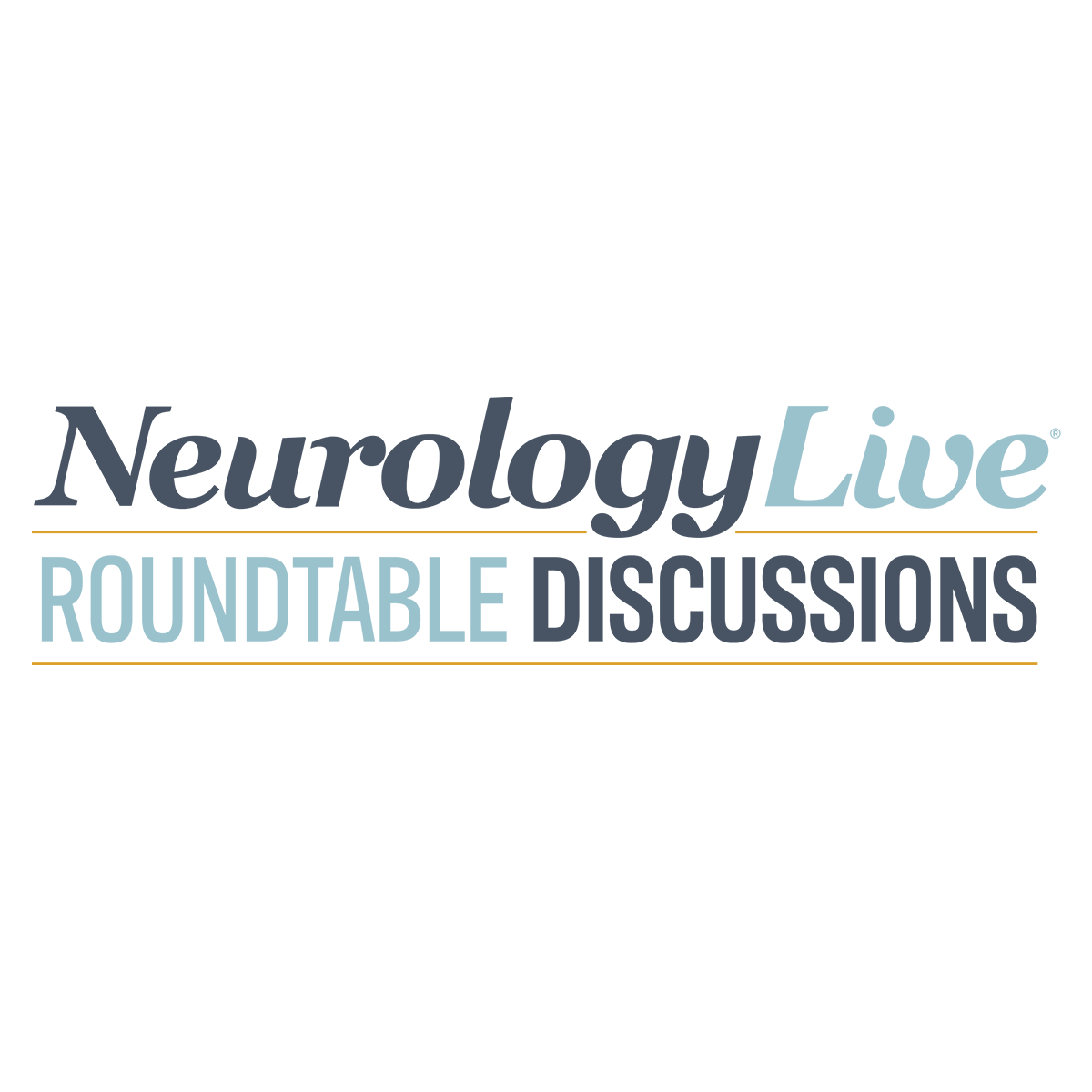
Unmasking Long COVID Through Understanding Prevalence and Diagnosis

In our latest roundtable series, experts discussed Long COVID prevalence, underreporting, accurate diagnosis, and emphasized that Long COVID serves as an umbrella term.
Episodes in this series
This content was originally published by our sister publication,
Since the start of the COVID-19 pandemic, the persistence or appearance of neurologic symptoms after clearance of SARS-CoV-2 infection has become a serious health challenge for patients and clinicians worldwide. The effects of postacute sequelae of SARS-CoV-2 infection (PASC), commonly known as
As emphasized by the research and experts in the field, currently there are no specific tests for the diagnosis of Long COVID, and clinical features such as laboratory findings and biomarkers may not specifically relate to the condition. It is important to develop and validate biomarkers for the prediction, diagnosis, and prognosis of Long COVID and its response to therapeutics. Regardless of age or preexisting health conditions, Long COVID can affect anyone, highlighting that this condition is not restricted to any specific demographic and does not discriminate, even against the healthiest individuals.
Recently, we conducted a Long COVID roundtable in collaboration with
Our panel of clinicians include:
- Ravindra Ganesh, MD, MBBS, FACP, Dip ABOM, general medicine doctor at the
Mayo Clinic and leader of their Long COVID clinic. Svetlana Blitshteyn, MD, FAAN , clinical associate professor of neurology at the University at Buffalo Jacobs School of Medicine and Biomedical Sciences, director of the Dysautonomia Clinic.Monica Verduzco-Gutierrez, MD, physical medicine and rehabilitation physician, professor, and chair of rehabilitation medicine at UT Health, leader of the Long COVID clinic.
Transcript edited for clarity.
Verduzco-Gutierrez: “Long COVID can be something that we know is very prevalent, but sometimes it is an invisible illness. People might not think that it's that much of an issue, but can be for sure. One thing that we see from numbers, if we look at household pulse survey, is probably somewhere close to one in five people in the United States have had to deal with Long COVID. Maybe they don't actively have it, and then we know that other studies have showed that one in 10 people who get COVID can have Long COVID and develop something related to Long COVID. So that number is significantly high, if you think of the number of people who've had infections, and the number of Americans, I think it was one in seven at one point, may have been dealing with Long COVID.”
Ganesh: “That number is probably higher when you consider demo to people with subclinical, Long COVID, who've had covid but haven't been quite as sharp afterwards, or haven't been quite 100%, and that number of people doesn't get reported, but you talk to patients, and they'll tell you they just haven't been quite right after having had COVID.”
Verduzco-Gutierrez: “One of the things I hear from researchers is that is it hard to recruit patients who've had COVID and completely return to normal. People say, "I have a little bit of brain fog," or "I have not been able to exercise just as much as I used to before." But maybe studies showing that the diagnoses given, maybe using the ICD 10 code of Long COVID is very low compared to what numbers of people that have it."
Blitshteyn: "It's important to establish that there was a COVID infection, some patients don't even realize. They presented to me with new onsets of neurologic symptoms or conditions. It's important to ask, “How did this start?” “Did you have COVID before the new onset of symptoms?” Sometimes it's a revelation to the patient that, “Oh, yeah, I had COVID.” The numbers are underestimated, because the patients may not realize that the prior COVID infection is related to the new onset of symptoms that they're having, and the infection may have been very mild and hardly visible, but we know the consequences may be significantly bigger than the original infection."
“The first thing I do is obtain a very thorough history of symptomatology, onset, preexisting conditions, comorbid conditions, medications, and how these symptoms affect the patient currently. Because I specialize in autonomic disorders, I end up getting the sickest patients. Therefore, I have a referral bias, and my patients tend to be quite sick, and by the time they see me, they have already seen their primary care physician, their cardiologist, their gastroenterologists allergists and other specialists. I obtain a history of medications, social history, (which means they're able to continue their employment). Many times, they are unable to engage in prior activities. Many of my patients are unemployed or unable to attend school, and there is a history of exercise intolerance. The patients identify that they were able to go to the gym or run or bike and now they can’t do it either, they're severely impaired, or they can do barely a walk around the block. Following that they get a family history; is there a family history for cardiovascular, neurologic and autoimmune disorders?”
“We obtain a thorough medication list, including vitamins and supplements, and then proceed with a review of the patient's history. Oftentimes, when assessing from head to toe, we recognize that many patients with Long COVID experience a significant symptom burden that spans multiple systems and organs. Symptoms can range from neuropsychiatric manifestations to muscular and skeletal issues, as well as allergic reactions and gastrointestinal disturbances, including sleep disturbances.”
“And then after that, we go straight to physical exam, which always includes a 10-minute stand test, which is the consensus guidance from multiple societies and organizations recommend because it's very important to establish whether there is evidence of orthostatic intolerance, including postural tachycardia or orthostatic hypotension. At least 70% of patients with Long COVID have autonomic dysfunction, so we try to assess for that, and then we proceed with physical exam includes neurologic examination.”
“Special attention is paid to neuromuscular exam, including all the sensation’s reflexes. Often there is a comorbid small fiber neuropathy. It's not uncommon for our patients with Long COVID to have reduced sensation of temperature and the pinprick distally and sometimes approximately in Apache distribution. There is a cardiovascular exam and skin exam because patients may have rashes. We must do an exam for joint hypermobility, because we know that people with joint hypermobility as a sign may be at risk for Long COVID.”
Verduzco-Gutierrez: “I would definitely say I still always want to see how, and document how their Long COVID symptoms impact their function and their quality of life. So especially, if they were working before, if they can't work; can they get out of bed? Can they spend time with their family? Are they having post exertional malaise? That's something in the history that I want to hear about, because we know that's something patients with Long COVID definitely have, other than just regular fatigue, and especially if you think someone that may eventually need disability, it's important that we document functionality as much as possible.”
Verduzco-Gutierrez: “Some patients, their manifestation of Long COVID is a picture of ME/CFS as well, because they have the criteria for that, because a lot of the criteria also are some of very similar to Long COVID symptoms, because they have post exertional malaise, they have unrefreshing sleep, some of them have autonomic dysfunction, cognitive deficits as well. Each of those individual things can be part of a Long COVID picture too. I won't say you can only have Long COVID, you can only have ME/CFS, depends on the history they may have both. They may have one, maybe they didn't have a SARScoV2 infection. ME/CFS has been around for decades and can happen from other infections or other things as well. It's going back to listening to the patient, listening to their history, seeing what the symptoms are and what criteria they meet.
Blitshteyn: “We have a number of studies that showed that at least 50% of patients with Long COVID qualify for the diagnosis of ME/CFS. It's certainly a subtype that we all need to learn how to assess and manage to the best of our abilities. Now, I think it's important to say that in addition to this phenotype, we must think about post-COVID conditions, because Long COVID is an umbrella term. We have to make sure that we allow cardiovascular manifestations, hyper coagulase, diabetes, metabolic abnormalities, hyperlipidemia, hypertension, that can often begin after COVID infection. Once we go through that process, and we arrive at something like, tests look normal, but the patient is still sick. We have to go with autonomic dysfunction and ME/CFS type of phenotype, and there we have to do our best to assess and also manage the symptoms. Because there are no FDA-approved therapists for Long COVID, but we certainly have a number of pharmacologic and non-pharmacologic measures to treat patients with autonomic disorders as well as ME/CFS.”
Ganesh: “Taking care of ME/CFS before Long COVID, we knew even then that about 70% of all cases of ME/CFS were related to an infection of sorts, and we have seen it with different infections, most commonly EBV (Epstein-Barr Virus), we were seeing it with chronic Lyme, reported mold exposure, and after Zika. We have seen after a bunch of different other infections before this. When I diagnose a patient with Long COVID, but what kind of Long COVID? Long covid with an ME/CFS phenotype plus autonomic dysfunction with GI predominance, you have to drill it down because can you devise a therapeutic regimen that may help your patient.”
Verduzco-Gutierrez: “One thing we know about, patients after COVID and with Long COVID, is that we've seen also those patients have viral reactivation. In bringing up EBV, then we know that sometimes after COVID, some patients have reactivation of EBV or other types of viruses, and then there's the issues that can come with that.”
Newsletter
Keep your finger on the pulse of neurology—subscribe to NeurologyLive for expert interviews, new data, and breakthrough treatment updates.































